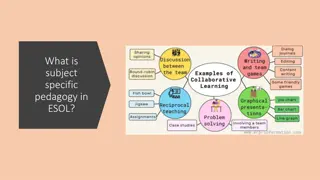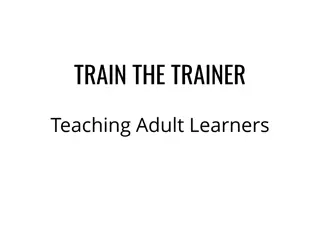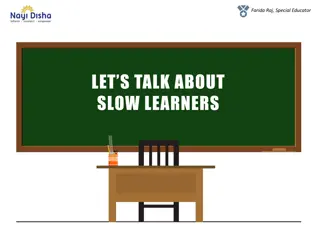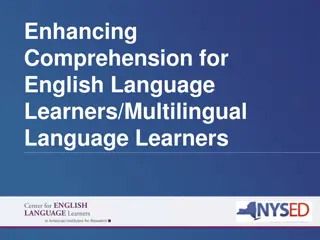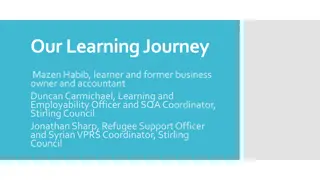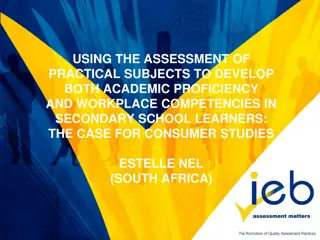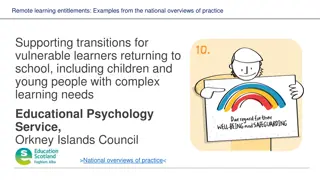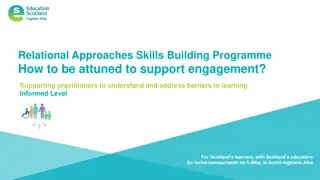Supporting ESOL Learners: Challenges and Strategies
Rewards and challenges of teaching ESOL learners, focusing on diverse student backgrounds, motivations, trauma effects, and the role of ESOL educators. Discussions include managing trauma in class, understanding student expectations, and creating a safe, supportive learning environment. Strategies for building positive relationships with students, assessing strengths and weaknesses, and addressing mental health issues are highlighted.
Download Presentation

Please find below an Image/Link to download the presentation.
The content on the website is provided AS IS for your information and personal use only. It may not be sold, licensed, or shared on other websites without obtaining consent from the author. Download presentation by click this link. If you encounter any issues during the download, it is possible that the publisher has removed the file from their server.
E N D
Presentation Transcript
Working with ESOL learners Celia Fisher - Senior Lecturer ESOL Glasgow Clyde College cfisher2@glasgowclyde.ac.uk Lyn Ma -Senior Lecturer ESOL Glasgow Clyde College lma@glasgowclyde.ac.uk
Rewards and Challenges Rewards and Challenges ESOL students are diverse but do have certain things in common. ESOL students are diverse but do have certain things in common. They desire to somehow forge a better life than the one they left behind. They desire to somehow forge a better life than the one they left behind. Melanie Cooke and James Simpson Melanie Cooke and James Simpson ESOL a critical guide ESOL a critical guide Making a difference Students motivation to learn Building positive teacher / tutor relationships with students Suitable Resources Range of Levels Ostrich or Saviour
The ESOL learner from a refugee background The ESOL learner from a refugee background Diverse educational backgrounds Jagged profiles Life situations that affect learning Expectations of the learner
Diverse backgrounds Diverse backgrounds jagged profiles & expectations jagged profiles & expectations What do students already know/ don t know? What are their strengths/ weaknesses? What are their expectations of the ESOL provision?
The effects of trauma, grief and loss The effects of trauma, grief and loss Difficult to concentrate & retain information Undiagnosed PTSD / other mental health conditions Physical ill health Anxiety about family in own country Anxiety about new life How can you manage this in a class?
Role of the ESOL teacher / tutor Role of the ESOL teacher / tutor The classroom time is lesson time The classroom time is lesson time, , and that is the time when they can just be a student and switch and that is the time when they can just be a student and switch off Melanie Cooke et al off Melanie Cooke et al Teach English . and, and, and .. Signpost students to appropriate agencies where possible Set clear boundaries about what their class time is for and when it is Provide a place that is calm and safe and where learning can take place. The classroom doesn t have to be four walls Remember to take care of yourself and your team otherwise you can t do your job effectively
Useful Resources Useful Resources Literacy resources suitable for ESOL learners not adult literacy learners ESOL readers promote independent learning- especially Gatehouse ESOL Activities / Exploring British Culture ESOL course books- English File, Cutting Edge, British Council NEXUS Mr Bean ! The Arrival Shaun Tan Songs Worksheets own or others
Scenarios that you may encounter. In small groups look at this possible situation you may encounter in a class. Chose a spokesperson to feedback to the whole group. Example: A student wants to stay behind after class to tell you about his problems with his housing situation. He is not happy with the area he lives in and would like to move. He is a low level learner. You have already given him a lot of time and attention. 1. Discuss what your response might be. 2. What are challenges for you in helping him in your particular locality ?
Scenarios 1. There is a unit on family in your course book. You know some of your students have lost close family members. 2. One of your students has recently had very bad news from her/his country and is very distressed. 3. You have noticed one of your students is very sleepy and you ask what is wrong. They disclose to you that they are feeling suicidal. 4. A low level student has been absent for a number of classes. You are concerned about them. 5. You have a couple of outspoken students who seem to have very strong, but opposing political opinions, and you sense a growing undercurrent of antagonism between them.





